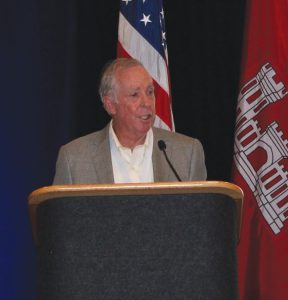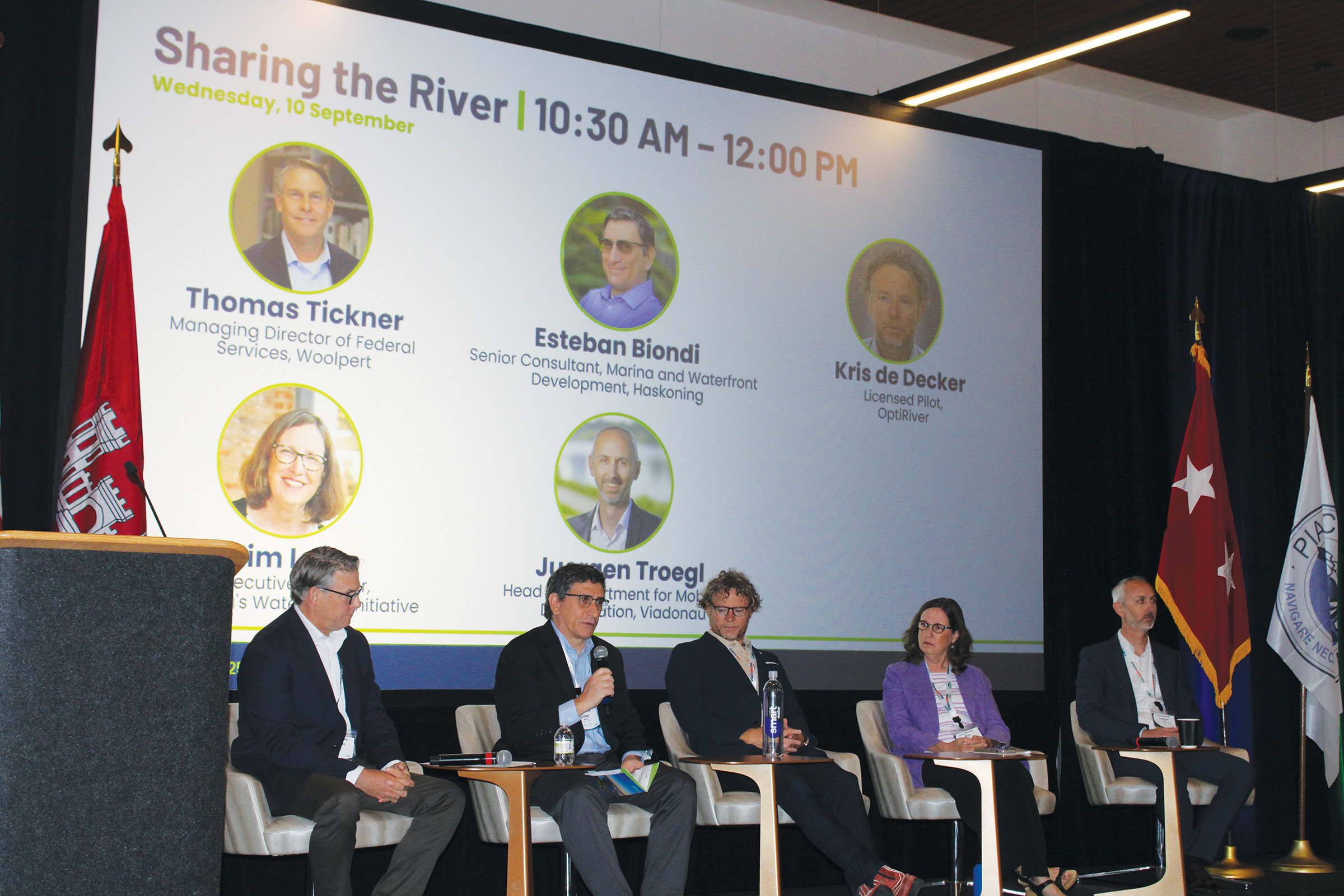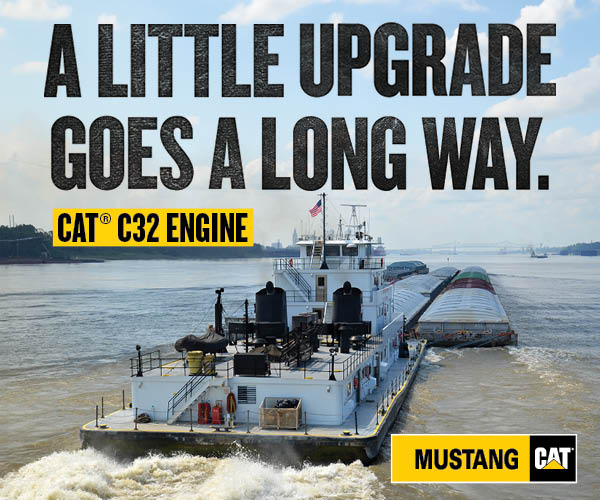When speaking about navigating disruptions at the Smart Rivers conference September 8-12 in Memphis, Tenn., Dan Pallme was nearly within sight of his leading example.
Pallme, intermodal director for the Tennessee Department of Transportation, explained to the international audience of about 300 people about how the Hernando de Soto Bridge across the Mississippi River in Memphis was shut down May 11, 2021, after a bridge inspector found a major crack in a key beam holding up one of the two spans. The closure snarled traffic across the bridge on Interstate 40 and also beneath it on the river.
Pallme noted that the bridge closure had an economic impact of $2.5 million per day on the trucking industry. All traffic was closed for 81 days. Westbound lanes reopened two days after eastbound lanes. While cars and trucks could detour down a smaller, older bridge in the meantime, towboats and barges didn’t have that option. The river was closed nearly four days, keeping an estimated 1,200 barges waiting.
“This was an incredible feat of every level of collaboration,” Pallme said, highlighting work by state and federal agencies and private industry to reopen the bridge as quickly as possible.
“I just cannot emphasize enough the collaboration, the partnership, of everybody doing one thing, and that was the safe return of operating this national corridor as quickly as possible,” Pallme said.
Pallme was the first speaker for the “Navigating Disruptions” panel discussion, moderated by Craig Philip, a research professor in civil and environmental engineering at Vanderbilt University and former president/CEO of Ingram Barge Company. The Smart Rivers 2025 conference was sponsored by PIANC USA on behalf of PIANC, the French acronym for the World Association for Waterborne Transport Infrastructure.
Jill Bessetti, southern region vice president for the American Waterways Operators, helped focus the crowd on the size of the inland waterways industry in the United States. Its 5,000 towing vessels and 33,000 barges comprise the largest segment of the U.S. flag fleet, she said. She highlighted major cargoes, including fuels, building materials and chemicals and noted that one barge of dry cargo can carry the same amount as 16 bulk rail cars or 70 trucks. For liquid cargoes, a tank barge can carry as much as 46 rail cars or 144 tanker trucks, she said.
The industry supports more than 270,000 jobs and carries more than 665 million tons of cargo each year, she said. She also focused on the importance of both recruitment and retention. One recent effort involves the creation of the Louisiana Maritime Academy to help teach potential recruits the skills they need to work on the river.
Paul Matthews, a certified port executive and former CEO of the Port of South Louisiana, spoke about disruptions on the Lower Mississippi, highlighting the 20th anniversary of Hurricane Katrina and fourth anniversary of Hurricane Ida this year.
“At the port of New Orleans, it was all about how we could get the river back up and running again because we understood the impacts that shutting down the Mississippi River, particularly the Lower Mississippi River, had to the rest of the country,” he said.
Shutting down the Mississippi River costs close to $200 million per day, with that number growing exponentially after the fourth day, Matthews said. Additionally, he cited disruptions from both high-water and low-water conditions and noted the importance of preparing years ahead when building infrastructure that can sustain extreme weather.
Like Pallme, Matthews also cited the importance of collaboration in recovering from disasters.
“The one silver lining is we no longer look at boundaries,” he said. “We no longer look at county or city or state boundaries because we’re all in this together.”
Moving ahead, he said it will be important to learn how to navigate the possibility of a new kind of disruption, caused by cybersecurity issues. He emphasized the importance of testing for system vulnerabilities.
Thomas Wagner, leader of the traffic technology division for the Federal Waterways and Shipping Agency in Germany, said Europe faces some different issues.
“We have rivers, but they are a little bit smaller,” he said.
Complicating transportation, however, is that Europe’s 7,300-kilometer (roughly 4,500 miles) network of rivers runs through multiple countries, with the Danube alone passing through 12.
That makes planning how to transport cargoes extremely complicated, Wagner said. As a result, the European Union and its collaborators have worked to launch a voyage planner website called EuRIS (https://www.eurisportal.eu). Users can enter their departure and destination points and receive information about all restrictions and regulations along various available routes for their vessel type and dimensions.
Wagner gave three examples of responding to navigation accidents: a capsized tanker on the Rhine River that was carrying dangerous cargoes, a remotely-operated ship hitting a lock gate on the River Moselle at full speed and a railway bridge on the Hunte River in Germany that was hit twice in two weeks.
“We had a growing number of accidents that caused severe damage to our own infrastructure, and this was new,” he said.
He expressed the importance of maintaining and monitoring infrastructure and planning for potential emergencies in advance.
“Critical impacts mostly occur suddenly and need an immediate response,” he said.
As in the United States, he said, “To make a waterway resilient is a big job. It costs a lot, and it takes a lot of human resources.”
Sharing The River

Panelists also addressed “Sharing the River” during a second plenary session at the conference. Tom Tickner, managing director of federal services for Woolpert, a global architecture, engineering and geospatial consulting firm, moderated the session, which included Esteban Biondi, coastal resilience and marina planning specialist; Capt. Kris de Decker, a licensed vessel pilot working for OptiRiver in Europe; Kim Lutz, executive director of America’s Watershed Initiative; Juergen Troegl, head of the Department for Mobility and Digitalisation at Viadonau, the leading Austrian waterway operator for the Danube region; and Amy Guise, chief of the planning division for the Baltimore Engineer District and lead for the Interstate Commission for the Potomac River Basin and the Susquehanna Basin Commission.
The panelists spoke about the importance of sharing information. Troegl noted this can be very difficult in Europe, where 16 countries involved in the waterway system have 13 primary languages. Additionally, he said, at one time users of European rivers might have had to look on as many as 70 different websites for information about various waterways. Centralizing that to one website supported by information provided from individual stakeholders has been important, he said.
Biondi said that, while often those building river infrastructure are most concerned about keeping them navigable to support the economy, they can sometimes collaborate when thinking about secondary goals, such as how modernizing infrastructure could also help with recreation, tourism or flood control. When conflicts exist, such as the interests of marinas compared to those of ports, he said it is important for decision-makers to “make sure everybody has a seat at the table” and for them to listen closely to understand the specific issues and then determine where there may be common ground.
Lutz talked about the importance of paying attention to less noticeable aspects of rivers. For example, she said more than 360 species of birds use the Mississippi River as a flyway for seasonal migration. The river is also important for commercial and subsistence fishing and for drinking water.
“I always like to say the question is not is ecology or economy more important,” she said. “You don’t need to ask that question. They are both important. If you’re asking which one is more important, you’re asking the wrong question.”
She mentioned the Navigation and Ecosystem Sustainability Program (NESP) on the Upper Mississippi River as an example where both interests were kept in mind when planning future projects along the river.
In Europe, small vessels often share portions of the river with large container ships, which can cause dangerous situations with wave action and a heightened risk of collision, de Decker said.
He noted that the Port of Antwerp on the Scheldt River in Belgium alone handles more than 250 million tons of cargo annually, compared to about 400 million tons for the entire Mississippi River. A strategy for handling that level of traffic has been to designate lanes of travel for different types of vessel use, with smaller vessels nearer the shoreline and larger ones in the main channel, he said.
“That’s actually drastically reduced the amount of incidents we have had,” he said.
Additionally, representatives from small sailing vessels and large oceangoing vessels have also jointly participated in “safety days” to stress their shared goal of keeping everyone safe on the waterways.
The Scheldt River is governed jointly by the Dutch and Belgian delegations, with the Belgian delegation more interested in the economy, driven by the Port of Antwerp, and the Dutch more focused on ecology, since its Port of Rotterdam in the Netherlands is on the North Sea coast and not on a river.
“So, (having) two nations with different interests is of course creating, on a geopolitical level, certain conflicts or challenges,” he said. “Luckily, we have united nautical authority on the highest level.”
That group of administrators works with the local and federal government groups to help make sure all interests are considered, he said.
De Decker noted that although shared, centralized information is great, it must still get into the hands of end users, and not all rivers have permanent internet connectivity. Additionally, he said, small boat captains and pilots may not have navigation software, like Rosepoint, on board. He pointed to advancements with satellite technology, including Starlink, as a possible solution.
Great Navigable Rivers
The closing plenary session of the conference, “Great Navigable Rivers,” was meant to be a culmination of the theme of “Celebrating the World’s Navigable Waterways.”
Panelists explained the significance of several of the complex river systems that support the world’s economies and cultures, describing international implications of governance along with the natural complexities and challenges and the management of infrastructure keeping them operational.
Panelists were Khun Busadee Santipitaks, CEO of the Mekong River Commission; Eduardo Queiroz, superintendent of waterways studies and projects for the Brazilian National Waterway Transportation Agency; Maj. Gen. Kimberly Peeples, commander of the U.S. Army Corps of Engineers’ Mississippi Valley Division; and Sim Turf, policy adviser for the Flemish Minisry of Mobility and Public Works. Steve Sattinger, senior program manager at Tetratech, moderated the session.
————
Featured photo caption: Esteban Biondi (second from left) makes a comment during the “Sharing the River” plenary session September 10 at the Smart Rivers 2025 conference in Memphis, Tenn. Others pictured (left to right) are moderator Tom Tickner of Woolpert, Capt. Kris de Decker of OptiRiver, Kim Lutz of America’s Watershed Initiative and Juergen Troegl of Viadonau.
(Photo by Shelley Byrne)




